北京大学人工智能概论知识点整理by高飙
人工智能概论知识点总结
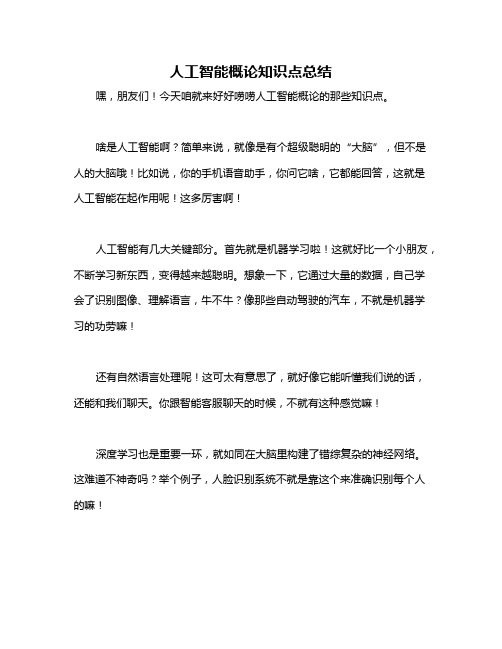
人工智能概论知识点总结
嘿,朋友们!今天咱就来好好唠唠人工智能概论的那些知识点。
啥是人工智能啊?简单来说,就像是有个超级聪明的“大脑”,但不是人的大脑哦!比如说,你的手机语音助手,你问它啥,它都能回答,这就是人工智能在起作用呢!这多厉害啊!
人工智能有几大关键部分。
首先就是机器学习啦!这就好比一个小朋友,不断学习新东西,变得越来越聪明。
想象一下,它通过大量的数据,自己学会了识别图像、理解语言,牛不牛?像那些自动驾驶的汽车,不就是机器学习的功劳嘛!
还有自然语言处理呢!这可太有意思了,就好像它能听懂我们说的话,还能和我们聊天。
你跟智能客服聊天的时候,不就有这种感觉嘛!
深度学习也是重要一环,就如同在大脑里构建了错综复杂的神经网络。
这难道不神奇吗?举个例子,人脸识别系统不就是靠这个来准确识别每个人的嘛!
那人工智能有啥好处呢?哎呀呀,那可太多了!它能帮我们做很多复杂又繁琐的工作,让我们省事儿不少呢!比如工厂里的自动化生产线,多高效啊!
但也有人担心它会不会带来一些问题呢?比如说失业问题,要是很多工作都被人工智能抢走了,那咋办呀?不过咱也不用太担心,人总是很聪明的嘛,可以去做更高级的工作呀!
我觉得啊,人工智能就是未来的趋势,我们得好好利用它的优势,同时也要注意解决可能出现的问题。
我们要和人工智能一起进步,让生活变得更加美好,不是吗?。
人工智能的知识点汇总

人工智能的知识点汇总人工智能(Artificial Intelligence,简称AI)作为现代科技领域的热门话题,涵盖了广泛的知识点和概念。
在本文中,我们将对人工智能的一些重要知识点进行汇总和介绍,以帮助读者更全面地了解这一领域的关键概念。
1. 人工智能的定义与分类人工智能是指计算机系统能够模拟人类智能的能力。
按照其智能水平和应用领域的不同,人工智能可分为弱人工智能和强人工智能,前者具有狭窄的智能范围,后者则拥有与人类智能相媲美的综合智能。
2. 机器学习机器学习是一种人工智能的子领域,研究如何让计算机通过训练数据自动学习规律和模式,并根据学习结果做出预测或决策。
主要的机器学习方法包括监督学习、无监督学习和强化学习。
3. 深度学习深度学习是机器学习的一个重要分支,其核心是人工神经网络。
通过搭建多层的神经网络模型,深度学习可以自动提取和学习数据中的高层次特征,从而实现对复杂问题的解决。
4. 自然语言处理自然语言处理是人工智能领域中研究如何让计算机理解和处理人类自然语言的技术。
它包括语音识别、机器翻译、文本分类、情感分析等各种任务。
5. 计算机视觉计算机视觉致力于让计算机具备与人类相似的视觉感知能力。
通过图像识别、目标检测、图像生成等技术,计算机视觉可以实现对图像和视频内容的分析和理解。
6. 推荐系统推荐系统是一种利用人工智能技术向用户提供个性化推荐的系统。
通过分析用户的行为和兴趣,推荐系统可以自动过滤和排序海量信息,给用户推荐相关的内容或产品。
7. 增强学习增强学习是一种能够使计算机在与环境交互中通过试错学习来获取最优策略的学习方法。
通过奖励机制和价值函数,增强学习可以让计算机自主地探索和学习如何在特定环境中获得最大的奖励。
8. 人工智能的应用领域人工智能在众多领域有着广泛的应用,包括医疗健康、金融、交通、教育、娱乐等。
例如,人工智能可以帮助医生进行疾病诊断、支持金融机构进行风险管理、改善交通系统的效率等。
《人工智能》知识点整理

《人工智能》知识点整理人工智能人工智能(Artificial Intelligence,AI),指由计算机程序和算法实现的拥有某种程度的智能的系统。
它是计算机科学领域的一个重要研究方向,广泛应用于各个领域,包括机器学习、自然语言处理、计算机视觉等。
一、人工智能的定义和发展历程人工智能的定义:人工智能是指通过模拟、扩展人的智能行为能力的机器和系统。
它通过学习、推理和处理信息来模拟人类的智能活动。
人工智能的发展历程:1. 推动人工智能发展的奠基人1950年代,图灵提出了著名的“图灵测试”,成为人工智能的奠基人之一。
20世纪60年代,达特茅斯会议上人工智能领域的研究者们开始开展系统性的研究。
2. 低谷期和复兴20世纪70年代至80年代,人工智能进入低谷期,遭到了一些怀疑和批评。
20世纪80年代末期,人工智能逐渐复兴。
3. 深度学习和大数据的崛起近年来,深度学习和大数据的兴起为人工智能的发展提供了强有力的支撑,使得有关人工智能的研究和应用在理论和实践上都取得了重大突破。
二、人工智能的分类人工智能的分类包括以下几个方面:1. 计算机视觉(Computer Vision)计算机视觉是指通过计算机和相应的算法使计算机系统具备对图像或视频的理解和处理能力。
应用领域:人脸识别、目标检测、图像分割等。
2. 机器学习(Machine Learning)机器学习是指通过让计算机自动学习和获取知识,从而实现某种特定任务的能力。
应用领域:推荐系统、自然语言处理、医疗诊断等。
3. 自然语言处理(Natural Language Processing)自然语言处理是指让计算机能够理解和处理人类自然语言的能力。
应用领域:机器翻译、智能客服、语音识别等。
4. 专家系统(Expert Systems)专家系统是一种拥有专业领域知识的计算机程序,通过推理和逻辑判断来解决问题。
应用领域:医学诊断、金融投资决策等。
三、人工智能的应用人工智能在各个领域都有广泛的应用,例如:1. 智能交通人工智能可以应用于交通领域,实现智能交通管理、车辆自动驾驶等。
《人工智能概论》课程笔记

《人工智能概论》课程笔记第一章人工智能概述1.1 人工智能的概念人工智能(Artificial Intelligence,简称AI)是指使计算机具有智能行为的技术。
智能行为包括视觉、听觉、语言、学习、推理等多种能力。
人工智能的研究目标是让计算机能够模拟人类智能的某些方面,从而实现自主感知、自主决策和自主行动。
人工智能的研究领域非常广泛,包括机器学习、计算机视觉、自然语言处理、知识表示与推理等。
1.2 人工智能的产生与发展人工智能的概念最早可以追溯到上世纪50 年代。
1950 年,Alan Turing 发表了著名的论文《计算机器与智能》,提出了“图灵测试”来衡量计算机是否具有智能。
1956 年,在达特茅斯会议上,John McCarthy 等人首次提出了“人工智能”这个术语,并确立了人工智能作为一个独立的研究领域。
人工智能的发展可以分为几个阶段:(1)推理期(1956-1969):主要研究基于逻辑的符号操作和自动推理。
代表性成果包括逻辑推理、专家系统等。
(2)知识期(1970-1980):研究重点转向知识表示和知识工程,出现了专家系统。
代表性成果包括产生式系统、框架等。
(3)机器学习期(1980-1990):机器学习成为人工智能的重要分支,研究如何让计算机从数据中学习。
代表性成果包括决策树、神经网络等。
(4)深度学习期(2006-至今):深度学习技术的出现,推动了计算机视觉、自然语言处理等领域的发展。
代表性成果包括卷积神经网络、循环神经网络等。
1.3 人工智能的三大学派人工智能的研究可以分为三大学派:(1)符号主义学派:认为智能行为的基础是符号操作和逻辑推理。
符号主义学派的研究方法包括逻辑推理、知识表示、专家系统等。
(2)连接主义学派:认为智能行为的基础是神经网络和机器学习。
连接主义学派的研究方法包括人工神经网络、深度学习、强化学习等。
(3)行为主义学派:认为智能行为的基础是感知和行动。
行为主义学派的研究方法包括遗传算法、蚁群算法、粒子群算法等。
《人工智能》知识点整理
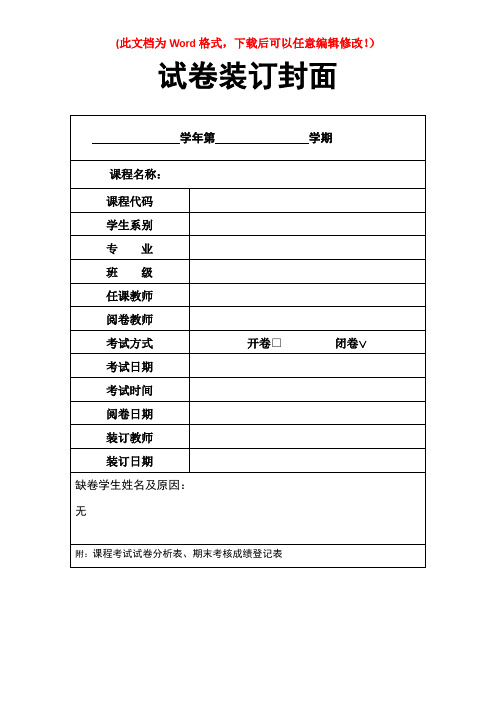
(此文档为Word格式,下载后可以任意编辑修改!)试卷装订封面《人工智能》知识点整理第二讲知识表示2.0.知识表示的重要性知识是智能的基础:获得知识、运用知识符合计算机要求的知识模式:计算机能存储、处理的知识表示模式;数据结构(List, Table, Tree, Graph, etc.)2.1 基本概念2.1.1 数据、信息与知识数据(Data)⏹信息的载体和表示⏹用一组符号及其组合表示信息信息(Information)⏹数据的语义⏹数据在特定场合下的具体含义知识(Knowledge)⏹信息关联后所形成的信息结构:事实& 规则⏹经加工、整理、解释、挑选、改造后的信息2.1.2 知识的特性⏹相对正确性⏹一定条件下⏹某种环境中⏹......⏹不确定性⏹存在“中间状态”⏹“真”(“假”)程度⏹随机性⏹模糊性⏹经验性⏹不完全性⏹...... ⏹可表示性& 可利用性⏹语言⏹文字⏹图形⏹图像⏹视频⏹音频⏹神经网络⏹概率图模型⏹......2.1.3 知识的分类⏹常识性知识、领域性知识(作用范围)⏹事实性知识、过程性知识、控制知识(作用及表示)⏹确定性知识、不确定性知识(确定性)⏹逻辑性知识、形象性知识(结构及表现形式)⏹零级知识、一级知识、二级知识(抽象程度)2.1.4 常用的知识表示方法⏹一阶谓词(First Order Predicate)⏹产生式(Production)⏹框架(Framework)⏹语义网络(Semantic Network)⏹剧本(Script)⏹过程(Procedure)⏹面向对象(Object-Oriented)⏹Petri网(Petri Network)⏹信念网(Belief Network)⏹本体论(Ontology)……2.1.5 如何选择合适的表示方法?⏹充分表示领域知识⏹有利于对知识的利用⏹便于理解和实现⏹便于对知识的组织、管理与维护2.2 一阶谓词表示法1. 优点⏹自然性⏹接近自然语言,容易接受⏹精确性⏹用于表示精确知识⏹严密性⏹有严格的形式定义和推理规则⏹易实现性⏹易于转换为计算机内部形式2. 缺点⏹无法表示不确定性知识⏹所能表示的知识范围太狭窄⏹难以表示启发性知识及元知识⏹未能充分利用与问题本身特性有关的知识⏹组合爆炸⏹经常出现事实、规则等的组合爆炸⏹效率低⏹推理与知识的语义完全割裂2.3 产生式表示法⏹1943年E. Post第一次提出⏹称为“Post机”的计算模型(《计算理论》)⏹一种描述形式语言的语法⏹AI中应用最多的知识方法之一⏹Feigenbaum研制的化学分子结构专家系统DENDRAL⏹Shortliffe研制的的诊断感染性疾病的专家系统MYCIN⏹……2.3.1 产生式的基本形式P → Q 或IF P THEN Q CF = [0, 1]其中,P是产生式的前提,Q是一组结论或操作,CF(Certainty Factor)为确定性因子,也称置信度。
人工智能知识点总结
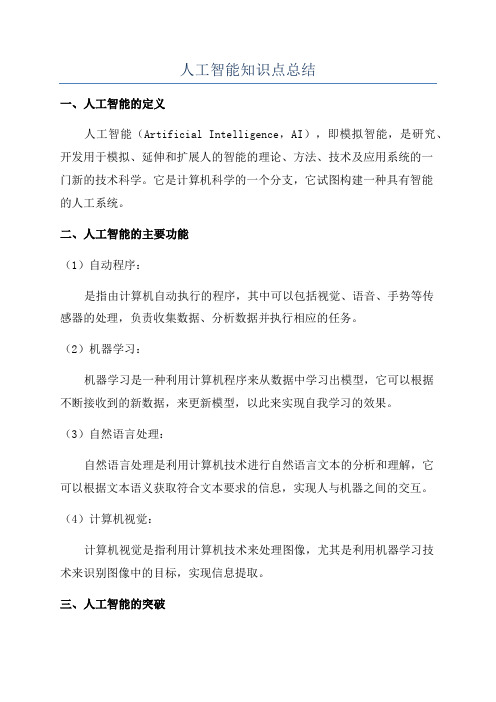
人工智能知识点总结
一、人工智能的定义
人工智能(Artificial Intelligence,AI),即模拟智能,是研究、开发用于模拟、延伸和扩展人的智能的理论、方法、技术及应用系统的一
门新的技术科学。
它是计算机科学的一个分支,它试图构建一种具有智能
的人工系统。
二、人工智能的主要功能
(1)自动程序:
是指由计算机自动执行的程序,其中可以包括视觉、语音、手势等传
感器的处理,负责收集数据、分析数据并执行相应的任务。
(2)机器学习:
机器学习是一种利用计算机程序来从数据中学习出模型,它可以根据
不断接收到的新数据,来更新模型,以此来实现自我学习的效果。
(3)自然语言处理:
自然语言处理是利用计算机技术进行自然语言文本的分析和理解,它
可以根据文本语义获取符合文本要求的信息,实现人与机器之间的交互。
(4)计算机视觉:
计算机视觉是指利用计算机技术来处理图像,尤其是利用机器学习技
术来识别图像中的目标,实现信息提取。
三、人工智能的突破
(1)计算机算法研究
计算机科学家和人工智能研究人员一直在探索最有效的算法,以便让计算机解决一些复杂的问题。
人工智能知识点总结大一
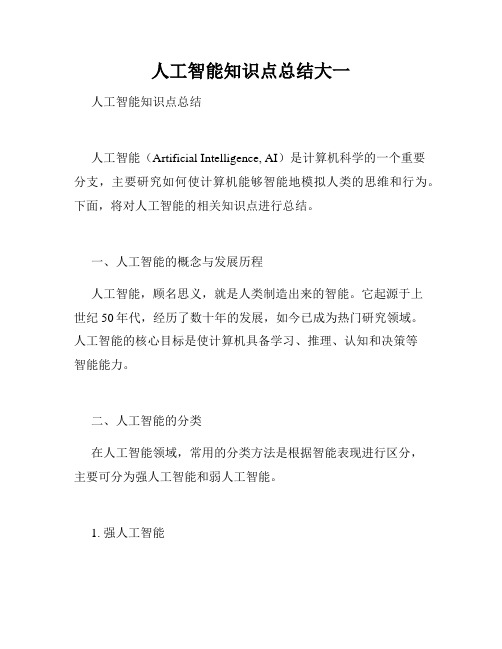
人工智能知识点总结大一人工智能知识点总结人工智能(Artificial Intelligence, AI)是计算机科学的一个重要分支,主要研究如何使计算机能够智能地模拟人类的思维和行为。
下面,将对人工智能的相关知识点进行总结。
一、人工智能的概念与发展历程人工智能,顾名思义,就是人类制造出来的智能。
它起源于上世纪50年代,经历了数十年的发展,如今已成为热门研究领域。
人工智能的核心目标是使计算机具备学习、推理、认知和决策等智能能力。
二、人工智能的分类在人工智能领域,常用的分类方法是根据智能表现进行区分,主要可分为强人工智能和弱人工智能。
1. 强人工智能强人工智能是指使计算机具备与人类相当甚至超过人类的智能水平。
这意味着计算机能够像人类一样进行思考、感知、学习和解决问题。
2. 弱人工智能弱人工智能是指使计算机在特定领域内表现出智能的能力。
许多已经实现的人工智能应用都属于弱人工智能,如语音识别、图像识别等。
三、人工智能的主要技术和方法人工智能的研究方法和技术多种多样。
以下是人工智能的几个主要技术和方法:1. 机器学习机器学习是人工智能的重要领域之一,是使计算机能够从大量数据中学习并提取特征,从而实现智能化的技术。
其中,监督学习、无监督学习和强化学习是常用的机器学习方法。
2. 自然语言处理自然语言处理是研究计算机和人类语言之间的交互的一门学科。
其目标是使计算机能够理解、分析和处理自然语言。
在人工智能中,自然语言处理应用广泛,如智能助理、机器翻译等。
3. 计算机视觉计算机视觉是指让计算机具备“看”和理解图像和视频的能力。
通过图像识别、目标检测等技术,计算机可以识别出图像中的物体、场景等。
4. 专家系统专家系统是一种模拟人类专家的知识和推理能力的计算机系统。
它基于大量的专家知识,通过推理和解决问题的方法,为用户提供具有专业水平的建议和解决方案。
四、人工智能的应用领域人工智能的应用涵盖了各个领域,如医疗健康、金融、交通、教育等。
人工智能的知识点整理

人工智能的知识点整理人工智能(Artificial Intelligence,简称AI)是一门探索人类智能的学科,旨在设计和构建能够思考、学习和执行任务的智能系统。
随着科技的快速发展,人工智能已经渗透到我们日常生活的方方面面。
在本文中,我们将对人工智能的一些主要知识点进行整理和总结,以便更好地了解这个领域的基础概念和应用。
一、机器学习(Machine Learning)1. 机器学习的基本概念机器学习是人工智能领域的核心技术之一,它通过让机器自动学习和改进来进行任务的执行。
机器学习的基本思想是通过训练数据集来构建一个模型,然后利用这个模型来进行预测或决策。
2. 机器学习的分类机器学习可以分为监督学习、无监督学习和强化学习三个主要类别。
监督学习利用标注的训练数据进行模型构建和预测;无监督学习则在没有标签的情况下寻找数据之间的隐藏结构和模式;强化学习通过在一个环境中进行试错学习,以最大化奖励函数的值来完成任务。
3. 机器学习的应用机器学习在各个领域都有广泛的应用,例如计算机视觉、自然语言处理、推荐系统、金融分析等。
它已经使得人工智能在许多任务上取得了突破性的进展。
二、神经网络(Neural Networks)1. 神经网络的基本原理神经网络是一种模仿人脑神经系统结构和工作机制的计算模型。
它由许多简单的处理单元(神经元)组成,这些神经元通过连接权重来传递和处理信息。
神经网络通过训练调整这些连接权重,以实现对输入数据的学习和识别。
2. 深度学习和卷积神经网络深度学习是神经网络的一种应用,它通过增加神经网络的深度和复杂度来提高模型的学习能力。
卷积神经网络是一种特殊类型的神经网络,主要用于处理图像和视觉数据。
3. 神经网络的应用神经网络在图像识别、语音识别、自然语言处理等领域具有广泛的应用。
它已经成为人工智能领域中的重要技术,推动了许多现实生活中的应用和服务的发展。
三、自然语言处理(Natural Language Processing)1. 自然语言处理的基本概念自然语言处理是研究计算机与人类自然语言之间交互的一门学科。
人工智能导论复习资料

人工智能导论复习资料一、什么是人工智能人工智能,简单来说,就是让机器像人一样思考和行动。
它不是一种单一的技术,而是一个涵盖了多种学科和技术的领域,包括计算机科学、数学、统计学、心理学、语言学等等。
想象一下,你有一个智能助手,它能理解你的需求,回答你的问题,甚至帮你完成一些复杂的任务,比如规划旅行、管理财务。
这就是人工智能在日常生活中的一种应用。
人工智能的目标是创建能够执行需要人类智能才能完成的任务的计算机系统。
这些任务包括学习、推理、解决问题、理解语言、识别图像和声音等等。
二、人工智能的发展历程人工智能的发展并非一蹴而就,它经历了几个重要的阶段。
在早期,科学家们就开始思考机器能否像人类一样思考。
20 世纪50 年代,人工智能的概念被正式提出,当时的研究主要集中在基于规则的系统和符号推理上。
然而,由于计算能力的限制和对智能本质理解的不足,人工智能在20 世纪 70 年代遭遇了第一次寒冬。
到了 20 世纪 80 年代,随着专家系统的出现,人工智能迎来了一次小的复兴。
专家系统是一种基于知识库和推理规则的系统,可以解决特定领域的问题。
但随着问题的复杂度增加,专家系统的局限性也逐渐显现。
近年来,由于大数据的出现、计算能力的大幅提升以及深度学习算法的突破,人工智能再次取得了巨大的进展。
图像识别、语音识别、自然语言处理等领域都取得了令人瞩目的成果。
三、人工智能的核心技术(一)机器学习机器学习是人工智能的核心领域之一。
它让计算机通过数据自动学习模式和规律。
机器学习有监督学习、无监督学习和强化学习等多种方法。
监督学习是最常见的一种,比如通过大量已标记的图片(比如猫和狗的图片)来训练计算机识别新的猫和狗的图片。
无监督学习则是让计算机在没有标记的数据中自己发现模式,例如将相似的客户分组。
强化学习是通过奖励和惩罚机制来训练智能体做出最优决策,比如让机器人学会走路。
(二)深度学习深度学习是机器学习的一个分支,它使用多层神经网络来学习数据的表示。
人工智能重点知识总结

人工智能重点知识总结
人工智能(Artificial Intelligence,简称AI)是一种模拟人类智
能的技术,包括机器研究、自然语言处理、计算机视觉等领域。
下
面是人工智能的重点知识总结:
1. 机器研究
机器研究是人工智能的重要分支,通过让计算机从数据中研究
和改进,来实现自主完成任务。
常见的机器研究算法包括决策树、
支持向量机、神经网络等。
机器研究在图像识别、语音识别、推荐
系统等领域有广泛应用。
2. 自然语言处理
自然语言处理是研究计算机与人类自然语言之间的交互的领域。
它包括文本分类、机器翻译、情感分析等任务。
自然语言处理的技
术可以帮助计算机理解和处理人类语言,从而实现智能的对话和交流。
3. 计算机视觉
计算机视觉是研究如何使计算机理解和解释图像和视频的领域。
它包括图像分类、目标检测、图像生成等任务。
计算机视觉的应用
非常广泛,包括人脸识别、车牌识别、图像搜索等。
4. 深度研究
深度研究是一种机器研究的方法,通过构建具有多个隐层的神
经网络,使计算机可以从大量数据中研究特征和模式。
深度研究在
人脸识别、语音识别等领域取得了重大突破,被广泛应用于各个行业。
5. 强化研究
强化研究是一种通过试错和反馈机制来训练智能体的研究方法。
智能体通过与环境交互,根据奖励信号来调整自己的行为。
强化研
究在游戏、机器人等领域有重要应用。
以上是人工智能的重点知识总结,希望对您有所帮助。
人工智能基础知识点总结

人工智能基础知识点总结一、什么是人工智能人工智能,简称 AI,简单来说,就是让计算机像人类一样具有学习、思考和解决问题的能力。
它不是简单的程序设定,而是能够通过大量的数据和算法进行自我学习和改进。
想象一下,你有一个非常聪明的“机器大脑”,它可以观察周围的世界,理解各种信息,然后根据这些信息做出决策和行动。
这就是人工智能在努力实现的目标。
二、人工智能的发展历程人工智能的发展并非一蹴而就,而是经历了多个阶段。
早期阶段,人们就对让机器具有智能充满了幻想和尝试。
但由于技术的限制,进展相对缓慢。
到了 20 世纪 50 年代,随着计算机技术的发展,人工智能开始真正成为一个研究领域。
在这个时期,科学家们尝试开发一些简单的程序,比如能够解决数学问题的程序。
然而,在接下来的几十年里,人工智能的发展遇到了一些挫折,比如计算能力的不足、数据的缺乏以及算法的不完善。
直到最近几十年,随着大数据、强大的计算能力和先进的算法的出现,人工智能迎来了快速发展的时期。
如今,我们看到人工智能在图像识别、语音识别、自然语言处理等领域取得了令人瞩目的成就。
三、人工智能的关键技术(一)机器学习机器学习是人工智能的核心技术之一。
它让计算机通过数据自动学习模式和规律。
机器学习有多种方法,比如监督学习、无监督学习和强化学习。
监督学习就像是有老师在旁边指导,计算机通过已知的输入和输出数据来学习预测新的输入对应的输出。
例如,通过大量的房屋面积和价格数据,来预测新房屋的价格。
无监督学习则是让计算机自己在数据中发现模式和结构。
比如,将一堆没有标签的客户数据进行分类,找出不同的客户群体特征。
强化学习则是通过奖励和惩罚机制,让计算机在不断的尝试和错误中学习最优的行动策略。
比如,让机器人通过不断尝试学会如何在复杂环境中行走。
(二)深度学习深度学习是机器学习的一个分支,它使用深度神经网络来学习数据的表示。
神经网络就像是人类大脑中的神经元网络,通过大量的连接和权重来处理和传递信息。
人工智能知识点整理与分享
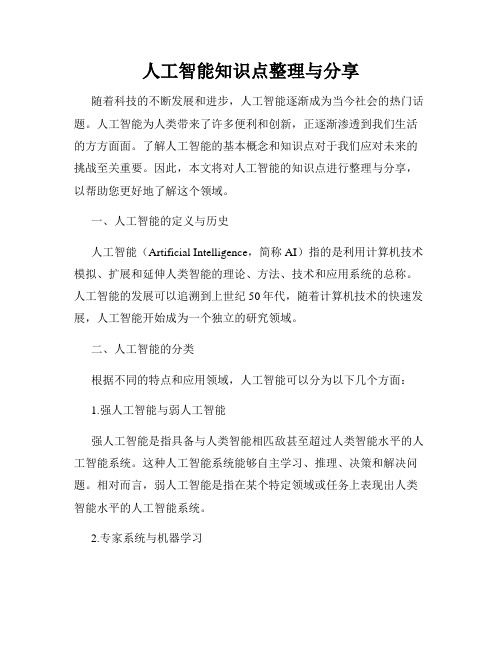
人工智能知识点整理与分享随着科技的不断发展和进步,人工智能逐渐成为当今社会的热门话题。
人工智能为人类带来了许多便利和创新,正逐渐渗透到我们生活的方方面面。
了解人工智能的基本概念和知识点对于我们应对未来的挑战至关重要。
因此,本文将对人工智能的知识点进行整理与分享,以帮助您更好地了解这个领域。
一、人工智能的定义与历史人工智能(Artificial Intelligence,简称AI)指的是利用计算机技术模拟、扩展和延伸人类智能的理论、方法、技术和应用系统的总称。
人工智能的发展可以追溯到上世纪50年代,随着计算机技术的快速发展,人工智能开始成为一个独立的研究领域。
二、人工智能的分类根据不同的特点和应用领域,人工智能可以分为以下几个方面:1.强人工智能与弱人工智能强人工智能是指具备与人类智能相匹敌甚至超过人类智能水平的人工智能系统。
这种人工智能系统能够自主学习、推理、决策和解决问题。
相对而言,弱人工智能是指在某个特定领域或任务上表现出人类智能水平的人工智能系统。
2.专家系统与机器学习专家系统是一种基于专家知识进行推理和决策的人工智能系统。
它通过提供问题和事实,以及一个基于专家知识的推理引擎来解决问题。
机器学习是一种通过让计算机系统从大量数据中学习并不断优化性能的技术。
它涉及到各种算法和技术,例如监督学习、无监督学习和强化学习。
3.自然语言处理与计算机视觉自然语言处理是指计算机与人之间进行自然语言交互和处理的技术。
它包括语音识别、语义理解、机器翻译等技术。
计算机视觉是指让计算机系统能够“看懂”图像和视频的技术。
它包括图像识别、目标检测、图像生成等方面的研究。
4.智能机器人与自动驾驶智能机器人是指能够感知环境、理解任务、执行动作的机器人系统。
它们通常搭载了各种传感器和执行器,并通过人工智能技术实现自主导航和任务执行能力。
自动驾驶技术利用人工智能技术使汽车等交通工具能够自主感知和决策,实现无人驾驶的功能。
三、人工智能的应用领域人工智能的应用已经渗透到各个领域,包括但不限于:1.医疗保健领域:利用人工智能技术进行医学影像分析、辅助诊断和治疗决策等。
人工智能概论笔记

人工智能概论笔记
以下是一份人工智能概论的笔记,供您参考:
1. 人工智能的定义:人工智能是一门研究、开发用于模拟、延伸和扩展人的智能的理论、方法、技术及应用系统的新技术科学。
2. 人工智能的起源:人工智能起源于20世纪50年代,随着计算机技术的
发展,人们开始探索如何让计算机模拟人类的智能。
3. 人工智能的研究领域:人工智能的研究领域包括机器学习、自然语言处理、计算机视觉、专家系统等。
4. 机器学习的定义:机器学习是人工智能的一个分支,它使用计算机算法让机器从数据中学习并做出预测或决策。
5. 自然语言处理的定义:自然语言处理是人工智能的一个分支,它研究如何让计算机理解和生成人类语言。
6. 计算机视觉的定义:计算机视觉是人工智能的一个分支,它研究如何让计算机从图像或视频中提取信息。
7. 专家系统的定义:专家系统是人工智能的一个分支,它使用计算机算法模拟专家的知识和推理过程,解决特定领域的问题。
8. 人工智能的应用:人工智能的应用包括智能语音助手、智能机器人、自动驾驶汽车、智能医疗等。
9. 人工智能的未来发展:随着技术的不断进步,人工智能将在更多领域得到应用,如智能城市、智能农业等。
同时,随着数据隐私和伦理问题的关注度不断提高,人工智能的发展也面临着越来越多的挑战和约束。
希望这份笔记能够帮助您更好地理解人工智能的基本概念和发展方向。
如果您还有其他问题或需要更深入的解释,请随时提问。
人工智能知识点归纳

人工智能知识点归纳人工智能(Artificial Intelligence,简称AI)是计算机科学的一个分支,旨在开发和构建能够模拟人类智能的机器。
随着技术的发展,人工智能在各个领域都得到了广泛应用。
本文将对人工智能的知识点进行归纳,帮助读者迅速了解该领域的基本概念和技术。
1. 人工智能概述1.1 定义:人工智能是指计算机系统通过学习、推理和规划等方式模拟人类智能的能力。
1.2 发展历程:人工智能起源于20世纪50年代,经历了符号主义、连接主义和深度学习的发展阶段。
1.3 应用领域:人工智能在机器学习、自然语言处理、计算机视觉等多个领域有广泛应用。
2. 机器学习2.1 概述:机器学习是人工智能的核心技术之一,通过让机器从数据中学习,不断优化算法和模型。
2.2 分类:机器学习可以分为有监督学习、无监督学习和强化学习三种类型。
2.3 常用算法:线性回归、决策树、支持向量机、神经网络等都是常用的机器学习算法。
3. 自然语言处理3.1 定义:自然语言处理是指让计算机能够理解、处理和生成自然语言的技术。
3.2 主要任务:分词、词性标注、命名实体识别、句法分析、语义角色标注等是自然语言处理的主要任务。
3.3 应用:智能聊天机器人、机器翻译、文本分类等是自然语言处理的常见应用。
4. 计算机视觉4.1 概述:计算机视觉旨在让计算机具备识别、理解和分析图像和视频的能力。
4.2 基本任务:图像分类、目标检测、图像分割、人脸识别等是计算机视觉的基本任务。
4.3 技术方法:卷积神经网络(CNN)、循环神经网络(RNN)、卷积神经网络等是计算机视觉的常见技术方法。
5. 智能推荐系统5.1 定义:智能推荐系统利用人工智能技术为用户提供个性化的推荐信息和服务。
5.2 工作原理:智能推荐系统通过分析用户的喜好和行为数据,利用机器学习算法生成个性化的推荐结果。
5.3 应用场景:电商平台的商品推荐、音乐、视频和新闻推荐等都是智能推荐系统的应用场景。
人工智能知识点总结

人工智能知识点总结在当今科技飞速发展的时代,人工智能(Artificial Intelligence,简称 AI)已经成为了最具影响力和变革性的技术之一。
从智能手机中的语音助手到自动驾驶汽车,从医疗诊断到金融风险预测,人工智能正在以惊人的速度改变着我们的生活和工作方式。
然而,要真正理解人工智能,我们需要深入了解其背后的关键知识点。
一、什么是人工智能人工智能是指机器模拟人类智能的能力。
它旨在让计算机能够像人类一样学习、思考、推理和解决问题。
人工智能不仅仅是简单的自动化,而是能够处理复杂的、不确定的和需要创造性思维的任务。
二、人工智能的发展历程人工智能的发展并非一蹴而就,而是经历了多个阶段。
早期的人工智能研究可以追溯到 20 世纪 50 年代,当时的科学家们对机器智能充满了乐观的预期。
然而,由于计算能力和数据的限制,早期的尝试并没有取得显著的成果。
到了 20 世纪 80 年代,专家系统成为了人工智能的一个重要应用方向。
专家系统通过将人类专家的知识和经验编码为规则,让计算机能够提供专业的建议和决策支持。
近年来,随着大数据的兴起、计算能力的提升以及深度学习算法的突破,人工智能迎来了新的发展高潮。
深度学习,特别是卷积神经网络和循环神经网络,在图像识别、语音识别、自然语言处理等领域取得了巨大的成功。
三、人工智能的核心技术1、机器学习机器学习是人工智能的核心领域之一。
它使计算机能够通过数据自动学习和改进。
机器学习主要分为监督学习、无监督学习和强化学习三大类。
监督学习:通过有标记的训练数据来学习预测未知数据的标记。
例如,通过已知的房屋面积和价格数据来预测新房屋的价格。
无监督学习:处理没有标记的数据,旨在发现数据中的隐藏模式和结构。
例如,对客户的购买行为数据进行聚类分析,以发现不同的客户群体。
强化学习:通过与环境进行交互并根据奖励信号来学习最优策略。
例如,让机器人通过不断尝试和学习来学会行走。
2、深度学习深度学习是一种基于神经网络的机器学习方法。
人工智能导论知识点

人工智能导论知识点汇总:1.人工智能是一门综合性的交叉学科和边缘学科。
2.人工智能的含义最早由一位科学家于1950年提出,并且同时提出一个机器智能的测试模型,请问这个科学家是图灵。
3.人工智能的远期目标是制造智能机器,近期目标是完成机器智能。
4.要想让机器具有智能,必须让机器具有知识。
因此,在人工智能中有一个研究领域,主要研究计算机如何自动猎取知识和技能,完成自我完善,这门研究分支学科叫机器学习。
5.编译原理不属于人工智能的研究的一个领域。
6.AI的英文缩写是Artifical intelligence。
7.“图灵实验〞是为了推断一台机器是否具备智能的实验,实验由三个封闭的房间组成,分别放置主持人、参与人和机器。
8.语义网络表达知识时,有向弧AKO 链、ISA 链是用来表达节点知识的继承性。
9.(A->B)∧A => B是假言推理10.命题是可以推断真假的陈述句11.问题归约法是指已知初始问题的描述,通过一系列变换把此问题最终变为一个子问题集合,这些子问题的解可以直接得到,从而解决了初始问题。
12.仅个体变元被量化的谓词称为一阶谓词13.MGU是最一般合一14.关系不在人工智能系统的知识包含的4个要素中15.当前归结式是空子句时,则定理得证。
16.或图通常称为状态图17.不属于人工智能的学派是时机主义18.所谓不确定性推理就是从不确定性的初始证据出发,通过运用不确定性的知识,最终推出具有肯定程度的不确定性但却是合理或者近乎合理的结论的思维过程。
( )19.用户不是专家系统的组成局部20.产生式系统的推理不包含简单推理21.C(B|A) 表示在规则A->B中,证据A为真的作用下结论B为真的信度22.在图搜索中,选择最有期望的节点作为下一个要扩展的节点,这种方法叫做有序搜索23.人工神经网络属于反应网络的是BP网络24.使用一组槽来描述事件的发生序列,这种知识表示法叫做剧本表示法25.产生式系统的推理不包含简单推理26.从已知事实出发,通过规则库求得结论的产生式系统的推理方法是正向推理。
(仅供参考)人工智能知识点总结

CHW:一、概论1.人工智能是由计算机科学、控制论、信息论、神经生理学、心理学、语言学等构成。
2.智能科学研究智能的基本理论和实现技术,是由脑科学、认知科学、人工智能等学科构成的交叉学科。
3.认知(cognition)是和情感、动机、意志等相对的理智或认识过程。
认知科学是研究人类感知和思维信息处理过程的科学,包括从感觉的输入到复杂问题求解,从人类个体到人类社会的智能活动,以及人类智能和机器智能的性质。
思维是客观现实的反映过程,是具有意识的人脑对于客观现实的本质属性、内部规律性的自觉的、间接的和概括的反映。
智能是个体认识客观事物和运用知识解决问题的能力。
4.人类思维的形态:感知思维、形象思维、抽象思维、灵感思维。
5.神经网络基本特点:①以分布式方式存储信息。
②以并行方式处理信息。
③具有自组织、自学习能力。
符号智能:以知识为基础,通过推理进行问题求解。
也即所谓的传统人工智能。
计算智能:以数据为基础,通过训练建立联系,进行问题求解。
人工神经网络、遗传算法、模糊系统、进化程序设计、人工生命等都可以包括在计算智能6.符号智能与计算智能区别:符号智能就是传统人工智能,以知识为基础,通过推理求解问题;计算智能以数据为基础,通过训练建立联系,进行问题求解。
人工神经网络,遗传算法、模糊等都是计算智能。
7.非单调推理:一个正确的公理加到理论中,反而使得所得结论变无效。
如封闭世界假设CWA,限定逻辑;定性推理:把物理系统分成子系统,对每个子系统之间的作用建立联系,通过局部因果性的行为合成获得实际物理系统的功能;不确定性推理:随机性、模糊性、不确定性。
如DS证据、模糊集、粗糙集、贝叶斯。
8.知识、知识表示及运用知识的推理算法是人工智能的核心,而机器学习则是关键问题。
机器学习的研究四个阶段:①无知识的学习:主要研究神经元模型和基于决策论方法的自适应和自组织系统。
②符号概念获取:给定某一类别的若干正例和反例,从中获得该类别的一般定义。
《人工智能》知识点整理

《人工智能》知识点整理
一、人工智能介绍
人工智能(Artificial Intelligence, AI)是计算机科学的一个分支,它企图了解智能的实质,并利用计算机模拟或延伸人的智能。
人工智能在机器学习、计算机视觉、语音识别、机器人技术等多个领域展现出惊人的发展和进步。
人工智能的技术领先程度被称为“AI热潮”或“AI革命”,并受到了世界各国的高度关注。
人工智能既是一种技术,也是一种学科,它涉及了多学科交叉的广泛与深入的理论研究和实践应用。
二、人工智能的分类
1、通用AI
通用AI是指拥有能力完成多种任务的AI,它可以在不同的任务和领域中有效地解决问题。
2、深度学习
深度学习(Deep learning)是一种机器学习技术,它利用计算机仿真神经网络的行为,从大量原始数据中学习有用知识和特征。
深度学习可以用于认知科学、图像处理、语音识别、机器翻译等研究领域。
3、机器学习
机器学习(Machine Learning)是AI中的一个分支,它是利用计算机系统从大量数据中发现有用的知识,而不需要人为干预。
机器学习包括聚类、线性回归、决策树、神经网络等技术。
4、自然语言处理
自然语言处理(Natural Language Processing, NLP)是计算机科学的一个研究领域,它研究如何理解和处理自然语言中的文本。
人工智能知识点总结
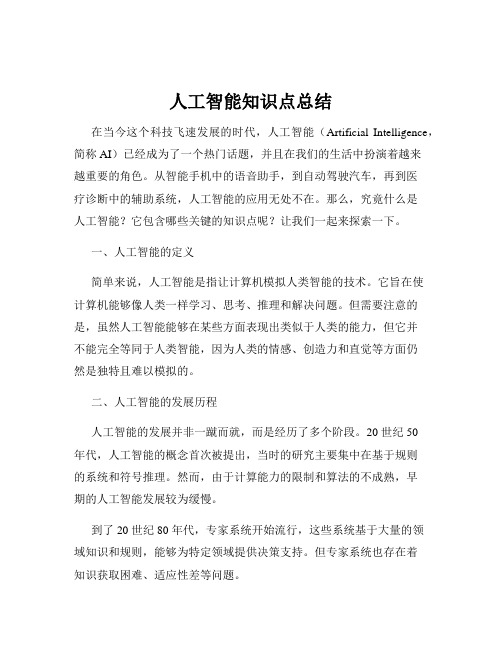
人工智能知识点总结在当今这个科技飞速发展的时代,人工智能(Artificial Intelligence,简称 AI)已经成为了一个热门话题,并且在我们的生活中扮演着越来越重要的角色。
从智能手机中的语音助手,到自动驾驶汽车,再到医疗诊断中的辅助系统,人工智能的应用无处不在。
那么,究竟什么是人工智能?它包含哪些关键的知识点呢?让我们一起来探索一下。
一、人工智能的定义简单来说,人工智能是指让计算机模拟人类智能的技术。
它旨在使计算机能够像人类一样学习、思考、推理和解决问题。
但需要注意的是,虽然人工智能能够在某些方面表现出类似于人类的能力,但它并不能完全等同于人类智能,因为人类的情感、创造力和直觉等方面仍然是独特且难以模拟的。
二、人工智能的发展历程人工智能的发展并非一蹴而就,而是经历了多个阶段。
20 世纪 50年代,人工智能的概念首次被提出,当时的研究主要集中在基于规则的系统和符号推理。
然而,由于计算能力的限制和算法的不成熟,早期的人工智能发展较为缓慢。
到了 20 世纪 80 年代,专家系统开始流行,这些系统基于大量的领域知识和规则,能够为特定领域提供决策支持。
但专家系统也存在着知识获取困难、适应性差等问题。
近年来,随着大数据的出现、计算能力的大幅提升以及深度学习算法的突破,人工智能迎来了新的发展高潮。
深度学习模型,如卷积神经网络(CNN)和循环神经网络(RNN),在图像识别、语音识别和自然语言处理等领域取得了显著的成果。
三、人工智能的主要技术1、机器学习机器学习是人工智能的核心领域之一。
它使计算机通过自动分析数据来学习模式和规律,从而能够进行预测和决策。
机器学习主要包括监督学习、无监督学习和强化学习。
监督学习:在有标记的数据集上进行学习,例如通过已知的输入和对应的输出数据来训练模型,常见的算法有线性回归、决策树、支持向量机等。
无监督学习:在没有标记的数据集中寻找模式和结构,例如聚类算法将数据分为不同的组。
人工智能的知识点梳理

人工智能的知识点梳理在人工智能领域中,存在着许多重要的知识点和核心概念,这些概念涵盖了从基本原理到高级应用的方方面面。
本文将对这些知识点进行梳理,以帮助读者更好地理解人工智能的本质和应用。
首先,人工智能可以定义为通过模拟人类智能的方法和技术来实现的一种科学和工程领域。
在人工智能中,机器学习是一项核心技术。
机器学习是指利用统计学和计算机科学的方法,使计算机系统能够从数据中学习并改进性能。
它可以分为监督学习、无监督学习和强化学习等不同类型。
监督学习是机器学习中最常用的方法之一。
它通过使用已标记好的数据样本来训练模型,以便模型能够从输入数据中预测正确的输出。
常见的监督学习算法有线性回归、决策树和支持向量机等。
无监督学习是指使用未标记的数据样本进行训练,通过模型自身的发现和推断来学习数据的潜在结构和模式。
聚类和降维是无监督学习中常用的技术。
聚类是将相似的数据样本分组,而降维是将高维数据映射到低维空间。
强化学习是一种通过奖励和惩罚来训练智能体作出决策的方法。
强化学习的目标是找到最优的策略,以最大化预期的累积奖励。
马尔可夫决策过程(Markov Decision Process)是强化学习的一个重要理论基础。
除了机器学习,人工智能还包括了许多其他的重要概念和技术。
例如,自然语言处理(Natural Language Processing)是指让计算机理解和处理人类语言的技术。
计算机视觉(Computer Vision)是指让计算机能够理解和分析视觉数据,如图像和视频。
知识表示和推理(Knowledge Representation and Reasoning)是指如何将知识表示为计算机可理解的形式,并通过推理和推断来进行智能决策。
与此同时,人工智能也涉及到一些伦理和法律问题。
例如,机器人伦理和数据隐私是当前人工智能面临的重要问题之一。
机器人伦理关注的是机器人的道德和社会责任问题,而数据隐私关注的是如何保护个人隐私和数据安全。
- 1、下载文档前请自行甄别文档内容的完整性,平台不提供额外的编辑、内容补充、找答案等附加服务。
- 2、"仅部分预览"的文档,不可在线预览部分如存在完整性等问题,可反馈申请退款(可完整预览的文档不适用该条件!)。
- 3、如文档侵犯您的权益,请联系客服反馈,我们会尽快为您处理(人工客服工作时间:9:00-18:30)。
AI整理By Gao Biao一、I ntroduction●AI的应用⏹Game playing, speech recognition, computer vision, mathematical theorem proving,natural language understanding, scheduling and planning.●Application Areas of AI In Robotics⏹Representation, Search, Inference, Learning, Planning●Robot⏹定义1:An automatic device that performs functions ordinarily ascribed to humanbeings → washing machine = robot?⏹定义2:A robot (industrial robot) is a reprogrammable, multifunctionalmanipulator designed to move materials, parts, tools, or specialized devices,through variable programmed motions for the performance of a variety of tasks.⏹定义3:A programmable machine that imitates the actions or appearance of anintelligent creature–usually a human.⏹特征:◆Sensing and perception: get information from its surroundings◆Carry out different tasks: Locomotion or manipulation, do something physical–such as move or manipulate objects◆Re-programmable: can do different things◆Function autonomously and/or interact with human beings●Why use robots?⏹4D environments : Dangerous, Dirty, Dull, Difficult⏹4A tasks : Automation, Augmentation, Assistance, Autonomous⏹Examples: Increase product quality, Increase efficiency, Increase safety, Reduce cost.●Robot Applications⏹Manufacture industry, Biotechnology, Military Applications, Fire Fighting\ Search\Rescue, Entertainment Industry.●Architecture of Robotic Systems⏹Mechanical Structure: Kinematics model, Dynamics model⏹Actuators: Electrical, Hydraulic, Pneumatic, Artificial Muscle⏹Computation & Controllers⏹Sensors⏹Communications⏹User Interface⏹Power conversion unitEnvironmentalsensors MotionplannerControllerMechanicalStructureConfigurationsensor二、S ensor●Sensor - an electrical/mechanical/chemical device that maps an environmental attributeto a quantitative measurement●Each sensor is based on a transduction principle - conversion of energy from one formto another●Sensor Fusion & Integration⏹Sensor fusion: Combine readings from several sensors into a (uniform) datastructure⏹Sensor integration: Use information from several sensors to do something useful⏹Why sensor fusion ??◆Real sensors are noisy◆Limited Accuracy◆Unreliable - Failure/redundancy◆Limited point of view of the environment◆The sensor of choice may be expensive●Sensors Used in Robot⏹Compass, Lidar, Sonar, IMU, Encoder…●Basic Navigation Techniques⏹Relative Positioning (called Dead-reckoning 航位推算法)–Problems: unbounded accumulation error⏹Absolute Positioning -- Magnetic Compasses, GPS …三、K inematics●●●●Two kinematics topics⏹Forward Kinematics (angles to position)⏹Inverse Kinematics (position to angles)四、M obility●Differential Drive⏹Advantages: Cheap to build, Easy to implement, Simple design⏹Disadvantages: Difficult straight line motion●Skid Steering(履带式)⏹Advantages: Simple drive system⏹Disadvantages: Slippage and poor odometry results, Require a large amount ofpower to turn●Synchro Drive⏹Advantages: Separate motors for translation and rotation makes control easier,Straight-line motion is guaranteed mechanically⏹Disadvantages: Complex design and implementation●Omni Wheels⏹Advantages: llows complicated motions⏹Disadvantages: No mechanical constraints to require straight-line motionComplicated implementation●Tricycle⏹Advantages: No sliding⏹Disadvantages: Non-holonomic planning required●Ackerman Steering⏹Advantages: Simple to implement⏹Disadvantages: Non-holonomic planning required●Articulated Drive:⏹Advantages: Simple to implement except for turning mechanism⏹Disadvantages: Non-holonomic planning is required●Framewalker⏹Advantages: Separate actuation of translation and rotationStraight-line motion is guaranteed mechanically⏹Disadvantages: Complex design and implementationTranslation and rotation are excusive●Snake Robots⏹Advantages: Many applications, Hyper-redundant⏹Disadvantages: Complex control and planning●Legged Robots⏹Advantages: Can traverse any terrain a human can⏹Disadvantages: Large number of degrees of freedomMaintaining stability is complicated五、M otion planning●The world consists of Obstacles & Free Space●The Configuration Space⏹What it is ?A set of “reachable” areas constructed from knowledge of both the robot and theworld⏹How to create it ?-Abstract the robot as a point object.-Enlarge the obstacles to account for the robot’s footprint and degrees fo freedom●Lumelsky Bug Algorithms⏹⏹Unknown obstacles, known start and goal.⏹Simple “bump” sensors, encoders.⏹Choose arbitrary direction to turn (left/right) to make all turns, called “localdirection”⏹Motion is like an ant walking around●Potential Functions⏹●The Wavefront Planner⏹ A common algorithm used to determine the shortest paths between two points⏹Representations: A Grid⏹●Roadmap Theory⏹⏹ A GVG is formed by paths equidistant from the two closest objects● Visibility Graph⏹六、 C omputer Vision● What is Computer Vision⏹ Input: images or video;Output: description of the worldBut also: measuring, classifying, interpreting, visual information● 3 Levels of Vision⏹ Low: Consider local properties of an image⏹ Mid: Grouping and segmentation⏹ High: Recognition● Applications⏹ In AI: vision serves as the “input stage”⏹ In medicine: understanding human vision⏹ In engineering: model extraction⏹ Low-Level (tech: Filters): Corner Detection, First stage of segmentation, Texturerecognition/ classification⏹ Mid-Level (tech: Clustering…): Segmentation / grouping, tracking⏹ High-Level (tech: Bayesian networks, Templates…): Face detection, PrincipalComponents Analysis(PCA), 3D scanning七、 C omputer Speech● Speech Recognition⏹ ApplicationsSpeech to text dictation, Voice controlled systems, Automated enquiry services ⏹● Speaker Identification⏹ ApplicationsSurveillance and forensics, voice controlled entry systems, Secure access to ATMs ⏹● Speech Synthesis⏹ ApplicationsAutomated information systems, Computer games, Aircraft cockpit flight information● Why is it difficult to process speech ?⏹ Speech signals are continuous . Speech signals are highly variable. s gSpeech is ambiguous.Speech is contaminated.(influenced by noise)Speech is highly complex.●Automatic Speech Recognition (ASR)⏹An ASR system converts the speech signal into words⏹ 3 Stages:◆Front-end for feature extraction (feature vectors)◆Pattern matcher for word or phoneme recognition◆Language model for sentence recognition●Another View for Speech Recognition System⏹How to represent the signal⏹How to model the constraints⏹How to search for the most optimal answer●Basic Speech Recognition Challenges⏹Co-articulation⏹Speaker independence⏹Spontaneous speech⏹Language modeling⏹Noise robustness。
